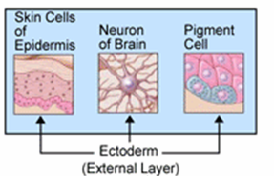Okay, #6 Principle courtesy of Dr. Jay Angevine,
Uniformity with Versatility
The vertebrate nervous system is accurately and reproducibly assembled. In animals of like genus and species it appears almost identical, although this is not absolute when genetic histories differ. Minor variations in the size of components and arrangements of cells are seen between species, striking ones between classes, orders and families. Yet basic regions and properties, cells and circuits, and overall organization are sufficiently alike to permit instant recognition off the basic brain plan and insights as to what these parts and cells contribute to function. Humans show increases in brain size and regional elaboration, numbers of neurons and prominence of certain connections, variations in cerebral sulcation, hemispheric asymmetry, and long projections."
Interesting principle to say the least. Here's what I got from it:
1) It looks like VERTEBRATES basically have the same nervous system plan. BASICALLY. Of course there are going to be differences but it shows how similar we are to other species, especially mammals.
My friend,
Diane Jacobs, PT wrote a little more on this, and I want to post it here because I could not have said it any better. In it she describes how little "bits" were added by nature throughout our evolution and why we have the same basic nervous system plan as other creatures, great and small. Thanks, Diane!!
Once nature came up with a way to do something at a cellular level and this cellular model survived all the predatory and thermodynamic slings and arrows, it became handed down more less intact. Neurons are highly useful, but expensive metabolically; once a working model became established it became highly conserved, replicated endlessly in all manner of species filling all manner of niches, each species phenotype using the basic neuron model in endlessly inventive ways.
As creatures evolved, bits got added to the nervous system, but nothing was ever really deleted from it. As a result, we share basic neuron structure design with animals that date back to the days prior to the division that occurred between vertebrates and our invertebrate cousins on the planet - everything considered "animal" has neurons, except for sponges. The list includes radially symmetric jelly fish, starfish, etc., insects... - all have neurons (i.e., we humans are not "special" for having neurons, but our neuron number and arrangement is - "specie-al" to humans).
As evolution proceeded our (really ancient animal) ancestors found their neuronally equipped selves becoming bilaterally symmetrical, better for getting a grip on the world to haul a little body physically perhaps, but requiring more hard drive to coordinate two sides. So the nervous system found itself clumped up a bit at one end. After that it was probably just more economical for special senses to evolve where there was already extra hard drive built in.
Everything after that, all the way to us, is a result of addition rather than truly different body plan. Apparently no other types of body plan were able to make it in the real world of predation and thermodynamic forces. So we share our bilaterally symmetric body plan with all other primates, quadrupeds, land vertebrates, and sea vertebrates including fish, who "invented" backbones and spinal cords, and everything else all the way back through time to whatever represents the fork in the road that led to worms on one side and fish ancestors on the other. Although worms lack a vertebral arrangement or any bones for that matter, they do have a bilaterally symmetric body plan, neurons, and a little "brain", up in front, to run all of it.
Questions? Comments? I'd love to hear from you.
In mind, body and spirit,
Will














